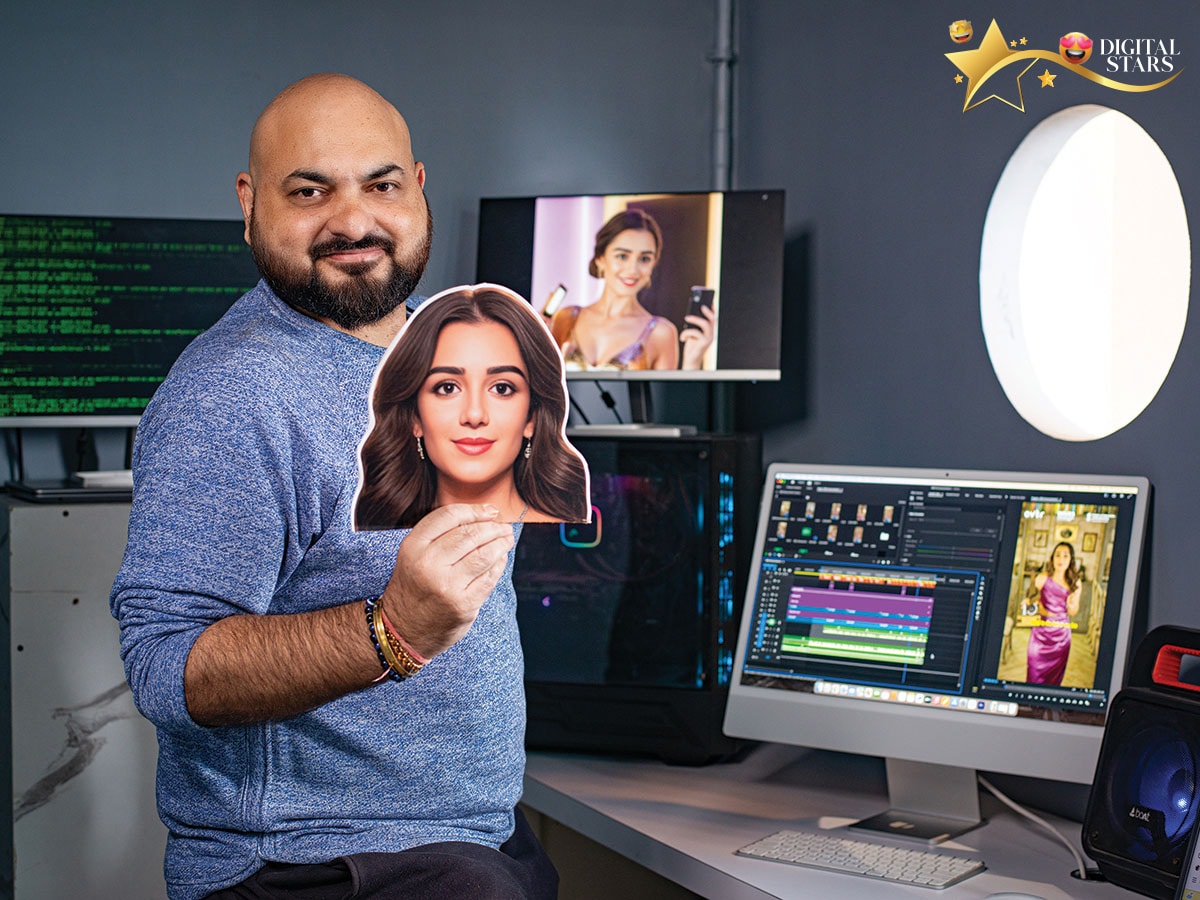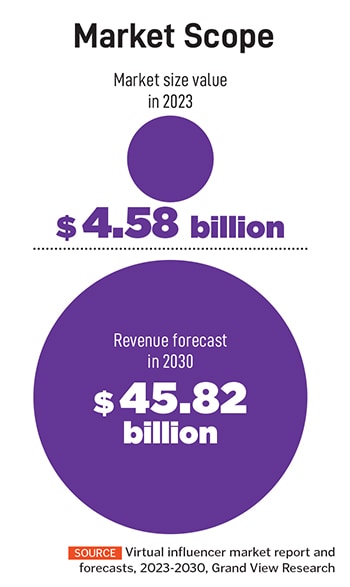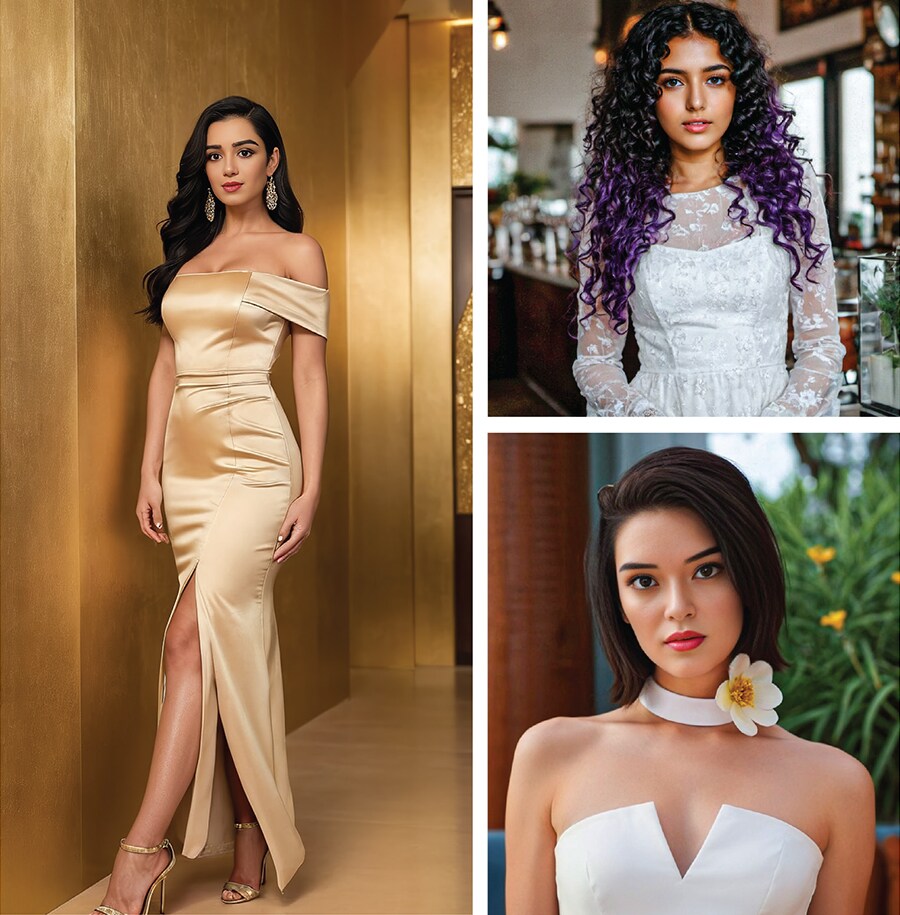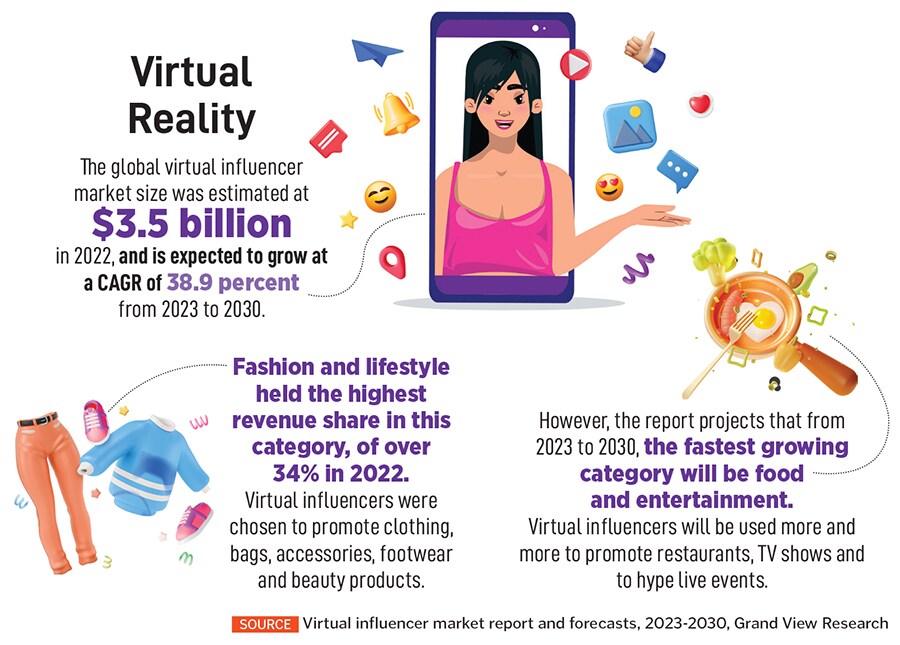 Abhishek Razdan, co-founder and CEO, AVTR Meta Labs, which created influencer Naina
Abhishek Razdan, co-founder and CEO, AVTR Meta Labs, which created influencer Naina
Image: Bajirao Pawar for Forbes India
She’s in Egypt one moment, and zooming off to space the next. She’s doing a ‘Khatron ke Khiladi’ task underwater today, and starring in an action film tomorrow. She’s showing off her new smart glasses, a Met Gala 2024 couture look, even a traditional Onam sari—Meet Kyra, the influencer who doesn’t exist.
Kyra is part of a small but growing tribe of ‘virtual’ influencers. This means that they are fictional characters, generated using artificial intelligence (AI) and CGI (computer-generated imagery), built to have personas, back-stories and specialties. What’s real, however, is the marketing moolah they can rake in.
Researchers at the Copenhagen-based ‘Influencer Marketing Hub’, which specialises in guides and reports on global social media and influencer marketing trends, found themselves surprised. In 2023, they added a new question to their ‘State of Influencer Marketing Benchmarking Report’, and noted that a whopping 60.4 percent of respondents had used virtual influencers. A year on, that number has risen to 62.2 percent.
A study in the US found that 58 percent of respondents followed a virtual influencer, the report notes. “It should come as no surprise that brands have taken notice of this virtual influencer trend and want to make financial arrangements with (the representatives of) these virtual influencers,” it states.
For a single video, a leading digital influencer could quote anywhere between ₹5 lakh and ₹10 lakh, at par with real, human content creators. Kyra, for instance, has 260,000 followers on Instagram and 103,000 on YouTube, and some of her popular brand-partnership videos have views that clock up to 74 million.
But why would a brand want to shell out its precious marketing budget to a virtual influencer, versus a popular human one? There are several reasons, experts say.
Click here for India’s Top 100 Digital Stars
Advantage AI
According to Kunal Sinha, a brand and digital strategy expert, there are five key reasons to pick a virtual influencer as part of a marketing campaign.
The first is that the technology offers the maker full control of the narrative. “When brands want to convey a specific message, being able to control what the influencer posts can be appealing, if they don’t want their messaging to be misrepresented, which can sometimes happen with a real influencer,” says Sinha, who is the chief knowledge officer at Malaysia-based agency Ampersand Advisory.
 Second, virtual influencers offer a whole lot of adaptability: They don’t age, can speak multiple languages, and can be made to travel to any place at no extra cost. “They are also available whenever you want to use them in a campaign,” he adds. “Brands can potentially use virtual influencers for campaigns in different regions, instead of identifying and engaging different ones in different markets.”
Second, virtual influencers offer a whole lot of adaptability: They don’t age, can speak multiple languages, and can be made to travel to any place at no extra cost. “They are also available whenever you want to use them in a campaign,” he adds. “Brands can potentially use virtual influencers for campaigns in different regions, instead of identifying and engaging different ones in different markets.”
Over time, it’s expected that AI influencers will become more cost-effective than human ones. “While the initial investment in development might be high, AI influencers do not require ongoing payments, travel expenses, or other logistical costs associated with human influencers,” Sinha says. “They can also generate content at scale, reducing the need for extensive content creation teams.”
Then there’s the novelty factor—social media users are likely to follow a virtual influencer because they are unexpected. “It’s a leap of faith, but some marketers believe that human influencers, especially the mega ones, are overexposed—and sometimes, their personal fame overshadows the brand,” he adds.
Importantly, AI influencers allow brands to explore new forms of storytelling and content creation, which may have been challenging, even impossible, for human influencers to pull off. “For instance, they can be animated with special effects, engaging audiences in more creative ways. This makes AI influencers a valuable asset for brands looking to push the boundaries of digital marketing and try out experimental campaigns,” says Sinha.
 George Tharian (left) and Himanshu Goel (right), the co-founders at FUTR Studios, created virtual influencer character Kyra in 2022
George Tharian (left) and Himanshu Goel (right), the co-founders at FUTR Studios, created virtual influencer character Kyra in 2022
Image: Nishant Ratnakar for Forbes India
A Whole New World
Kyra launched in 2022, and has done 15 brand campaigns, including those with L’Oreal Paris, BoAT, Amazon Prime Video, American Tourister and Titan. Because she was made largely before the generative AI wave hit, she isn’t made to look realistic, but more like a video game character.
“We looked at the success of virtual influencers like Lil Miquela from Brazil (2.5 million Instagram followers) and Imma from Japan (392,000 Instagram followers) and noticed a gap in India, and the potential to have an early-mover advantage,” says Himanshu Goel, co-founder of Bengaluru-based Futr Studios, which calls itself a ‘virtual human company’.
The idea is to create not just influencers, but customer care executives, chatbots, sales agents and so on. Futr Studios has received pre-seed funding from 100x.vc, raising $150,000.

Kyra is an influencer in the fashion, lifestyle and fitness space. Goel and his co-founder, George Tharian, both come from media and marketing backgrounds, and conceptualised Kyra through a process similar to that of making a film, taking a character from drawing board and script-writing to screen. She comes to life using a blend of 3D technology, including software such as Unreal Engine and Maya, used to make video games and movies typically.
Interestingly, another digital influencer called Naina, who comes from the stables of Mumbai-based Avtr Meta Labs, uses an entirely different approach. While Kyra is visibly digital and often stars in futuristic, computer-generated settings, Naina lives and creates content in the real world, collaborating with real people, including celebrities.
Naina is made using what Avtr calls a ‘body double’. This means that a real, human model shoots a video—that video goes back into the lab and the model’s face is swapped with that of an AI-generated one, of Naina. Voice swap technology gives her a rounded personality of her own—using the same technology as a deepfake video would.
“AI technology is moving really fast, but it still has its limits,” Abhishek Razdan, co-founder and CEO of Avtr Meta Labs, says. “So, if I want Naina to come talk to you at your office in a video, I can’t do that just using technology. People are really excited when Naina meets a Bollywood celebrity, for instance, and intrigued by how it all works.”
The other advantage of this technology, he says, is that it can be quickly adapted to suit different audiences. “I can swap the face for a Korean one, or a British or Latin one,” he adds. “And I don’t have to fabricate the lip sync while dubbing—this saves us a lot of dollars, and also allows us to make a lot of dollars, because the main market for this is in the US currently.”
Avtr’s plan is to move their characters beyond the influencer space, and into entertainment, creating short, snackable episodes of fictional content, designed for social media. The studio, which is an arm of marketing firm Concept Communication, is bootstrapped, but will look to raise funding soon.
 (Clockwise from left) AVTR’s virtual influencer Naina; Futr Studios’s Sravya and Kyra
(Clockwise from left) AVTR’s virtual influencer Naina; Futr Studios’s Sravya and Kyra
“When we launched Naina in October 2022, she was designed to be a beauty and fashion influencer,” Razdan says. “But over time, we’ve positioned her as a lifestyle influencer, since we’re seeing brand interest from across categories, including entertainment and technology. A lot of tech companies are partnering with us to launch gadgets, mobile phones and so on, since the AI connection makes sense to them.”
Avtr also has another influencer, a ‘man’ called Virat. “But to be more efficient with budgets, we’re currently focussed largely on Naina,” he adds. “However, there is a dearth of solid male influencers in the market, so we do think there’s a great opportunity there.”
Both Naina and Virat operate on the same body double technology. “If I had 10 influencers that could generate good payoff, it would make sense investing in an all-AI technology,” Razdan adds. “That doesn’t come cheap either. Our agenda is to launch many characters, and to be an AI content company.”
Naina currently quotes about ₹6 lakh to ₹8 lakh per reel. For a larger campaign with mobile phone giant Oppo, the firm made about ₹22 lakh to manage the whole campaign, including production costs.
“Our younger audience is really interested in seeing the miracle of AI, which is what makes Naina so popular,” he adds. “Another advantage is that we have control of the entire narrative, and that an AI influencer is largely free of controversy.”
Also read: My followers tell me that I make people laugh, so I’ll never be sad: Karishma Gangwal
Sliding into DMs
While a virtual influencer is likely to be less opinionated, and less controversial, the technology is not without its cons, and dangers.
To start with, an AI influencer will lack a ‘human touch’, have lower authenticity, and, therefore, may not resonate as much with the audience. Ethical concerns over biases and body and beauty standards persist; most popular virtual influencers are women, and project a certain body type, adhering to mainstream standards of beauty.

They aren’t immune to unsolicited propositions either. Naina’s DMs, Razdan says, are peppered with flirty texts from men. With Kyra, who has the ability to generate appropriate responses to a large volume of DMs, people are seeking relationship advice as well as fashion advice.
“Because she’s a fashion influencer, we’ve given her the ability to ingest a whole lot of data, and recommend actual fashion options—this is another way we can integrate with brands,” Goel says.
He adds that Kyra has received upwards of 200,000 messages from about 15,000 people on Instagram—people who are interested in having full-fledged conversations with the digital influencer. “We’ve made it such that our team is unable to see who sends the DM, to maintain a level of confidentiality,” Goel adds.
In one conversation, a user is complaining to Kyra that she proposed to her love interest, but he declined “because I have a pimple on my face”. “Oh no. Pimples don’t define beauty. You deserve better,” was Kyra’s response. In another, she advises a young user to be themselves when trying to impress their crush.
People also DM Kyra asking for advice on which phone, motorbike or sneakers to buy. They can personalise their queries, and Kyra will recommend an exact match based on their requirements. “Integrating machine learning (ML) into the interactions of AI influencers will undoubtedly make them better, more authentic and empathetic,” Sinha says. “Quite like the use of ML in clinical diagnosis, the relationship, or beauty advice provided by them can potentially be based on thousands of responses already available, and be as conversational as a real therapist’s.”
However, the flipside is that since influencer marketing is based on peer-to-peer recommendation, some users question how AI can offer advice around which products to try, since they haven’t physically tried or experienced the item they are promoting. “This can point to an issue regarding authenticity—are AI influencers promoting products for the sake of it? If so, that goes against everything the influencer space has forged over the years,” says Sinha.
Brands need to be transparent about the use of AI technology, and ensure that their campaigns comply with relevant laws and regulations, he adds.
Research shows that most demand for virtual influencers comes from the fashion, beauty, lifestyle, entertainment and technology categories. Like with Kyra, who provides her audience with a personalised recommendation engine and conversation avenue, it is possible for virtual influencers to form loyalties with their followers.
However, researchers have also noted that the type of product being endorsed plays a crucial role in determining a virtual influencer’s effectiveness. “When it comes to functional products, virtual influencers hold their own against human ones,” Sinha says. “But for symbolic products, or those that act as status symbols, or those that help consumers express an identity, humans still have the upper hand.”
(This story appears in the 18 October, 2024 issue
of Forbes India. To visit our Archives, click here.)
